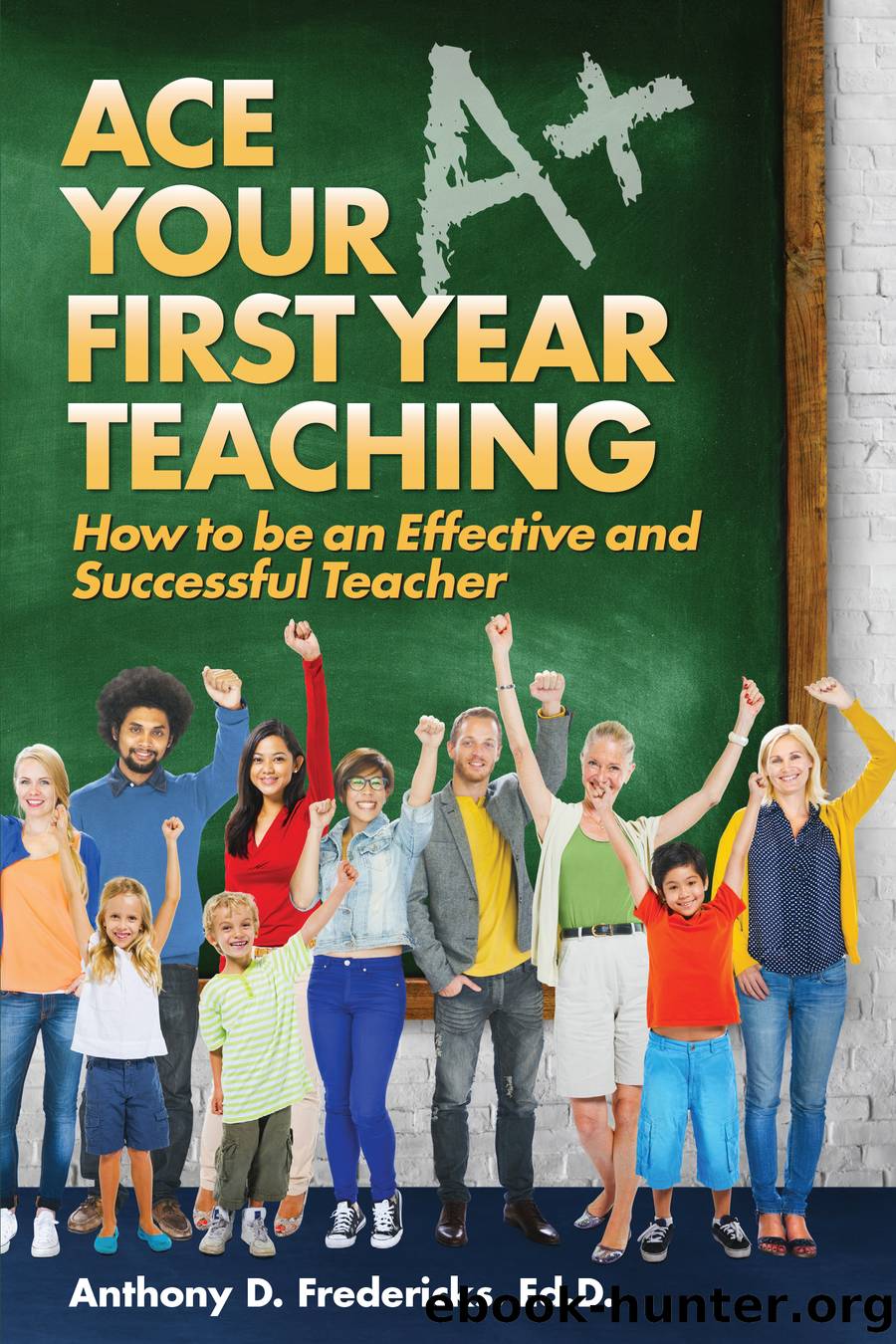Ace Your First Year Teaching by Anthony Fredericks

Author:Anthony Fredericks
Language: eng
Format: epub
Publisher: Blue River Press
Published: 2017-08-15T00:00:00+00:00
A Word of Advice
“Behavior management is the key to all of your success during your first year teaching. You may not always know what to do or what the best choice is to make, but when you have mutual respect, communication, rules and boundaries in your classroom, your children have the best possible chance to really learn and grow.”
—Amanda Cuff, current elementary teacher
A Few Words on Discipline
You may have noticed that in this chapter, as well as the two preceding chapters (9 & 10), I have not used the word “discipline.” That has been intentional. That’s simply because a well-managed classroom does not have to resort to discipline. In fact, there is considerable research to support the notion that outstanding teachers are those who manage their classrooms; while ineffective teachers are those who discipline their students. Let’s look at this concept in more detail.
As you will recall from Chapter 5, the establishment of classroom procedures should be one of the first things you need to do at the start of a new school year. Those procedures are at the heart of a well-established and well-maintained classroom management plan. They clearly delineate expectations of behavior as well as the consequences for anything that would violate those expectations.
Discipline, on the other hand, is an “after-the-fact” event: something that occurs AFTER a rule or standard has been violated. It does not establish good behavior up front, rather it punishes bad behavior as a concluding event. In other words, discipline temporarily stops misbehavior; it does not reinforce the good behavior every classroom needs. Or, as one colleague put it, “No learning takes place when you discipline, only a large interruption in that learning!”
Let’s take a closer look at the differences between “Procedures” (as emphasized throughout this book) and “Discipline” (as emphasized in those “Brand X” books):
Procedures Discipline
Established before the fact Occurs after the fact
How things are done How students behave
No penalties or rewards Penalties and rewards
Intrinsic Extrinsic
Student self-responsibility Teacher directed
Sets standards for appropriate behavior Temporarily stops misbehavior
Control from inside Control from outside
Statements of student expectation Statements of condemnation
Productive learning time Wasted learning time
Increases time-on-task time Decreases time-on-task time
How the classroom is organized How students should comply
In your review of the chart above you will undoubtedly see that discipline is reactionary—that is, it is a reaction to something (usually negative) that a student has done. Procedures, on the other hand, provide everyone in a classroom with standards of expected behavior long before any possible disruption of that behavior. With procedures, there are no assumptions that students intuitively “know how to behave.” The guidelines and standards are clearly spelled out and clearly delineated. Everybody knows what is to be done from Day One.
Students who have been in school for any length of time come into a new classroom with certain expectations and certain assumptions. Here are some common ones:
•The teacher makes the rules.
•Kids follow the rules.
•Kids will break the rules.
•The teacher will discipline the kids.
Look again at those statements and you’ll notice they are all teacher-centered. If the kids do things right, everything’s OK with the teacher.
Download
This site does not store any files on its server. We only index and link to content provided by other sites. Please contact the content providers to delete copyright contents if any and email us, we'll remove relevant links or contents immediately.
The Motivation Myth by Jeff Haden(5113)
Audition by Ryu Murakami(4756)
Adulting by Kelly Williams Brown(4426)
The Confidence Code by Katty Kay(4143)
A Mind For Numbers: How to Excel at Math and Science (Even If You Flunked Algebra) by Barbara Oakley(3173)
Waiting in the Wings by Melissa Brayden(3140)
Self-Esteem by Matthew McKay & Patrick Fanning(3026)
Nice Girls Don't Get the Corner Office by Lois P. Frankel(2964)
Fooled by Randomness: The Hidden Role of Chance in Life and in the Markets by Nassim Nicholas Taleb(2959)
The ONE Thing by Gary Keller(2955)
The Dictionary of Body Language by Joe Navarro(2868)
How to be More Interesting by Edward De Bono(2706)
Designing Your Life by Bill Burnett(2615)
Getting Things Done by David Allen(2606)
The Plant Paradox by Dr. Steven R. Gundry M.D(2500)
Police Exams Prep 2018-2019 by Kaplan Test Prep(2435)
What Color Is Your Parachute? 2015 by Richard N. Bolles(2221)
Dangerous Personalities by Joe Navarro(2198)
When to Jump by Mike Lewis(2065)
